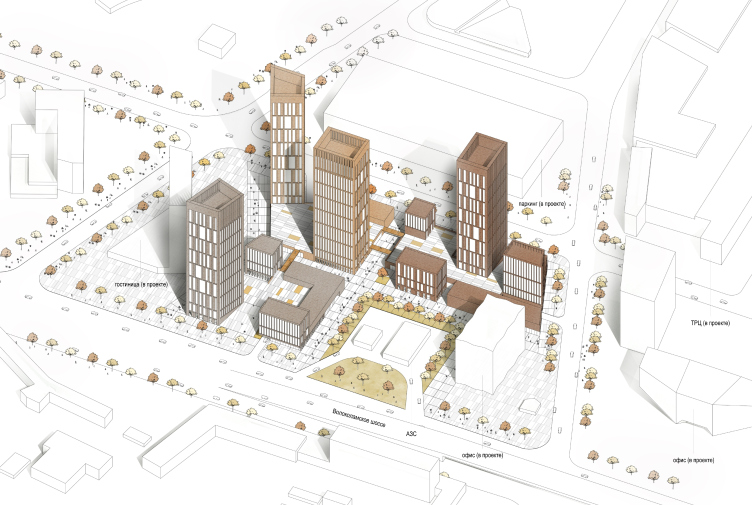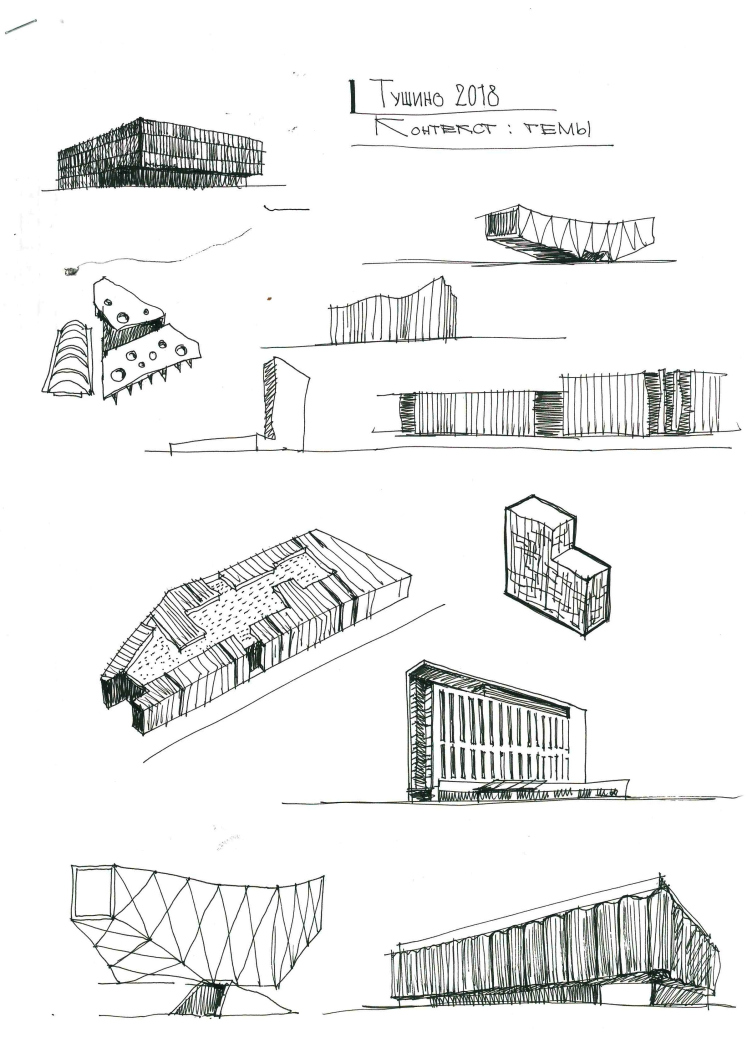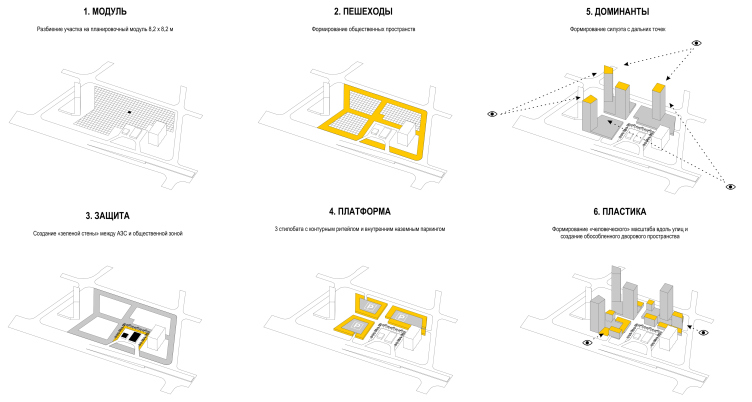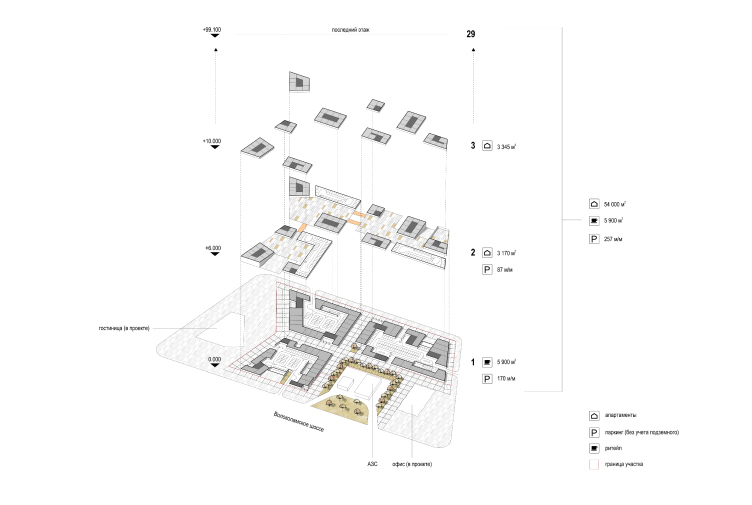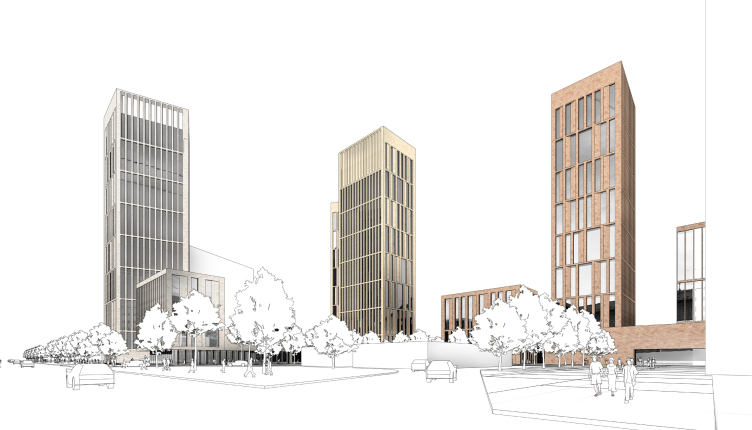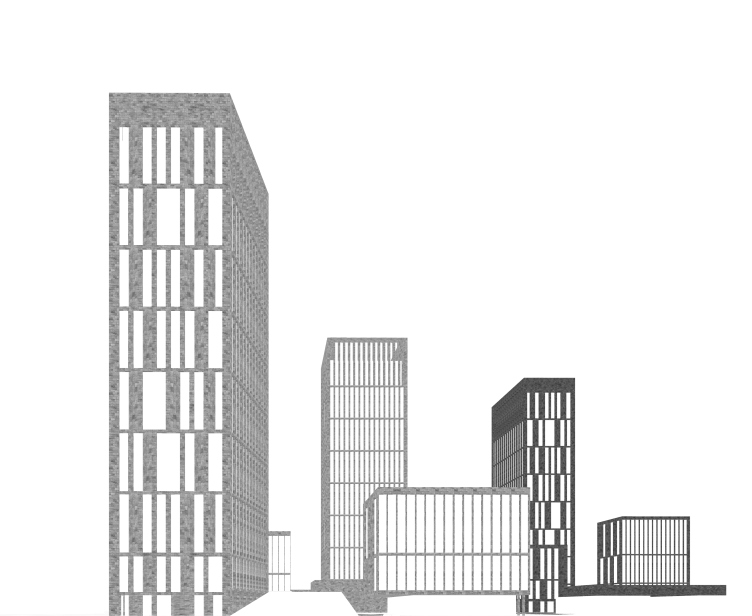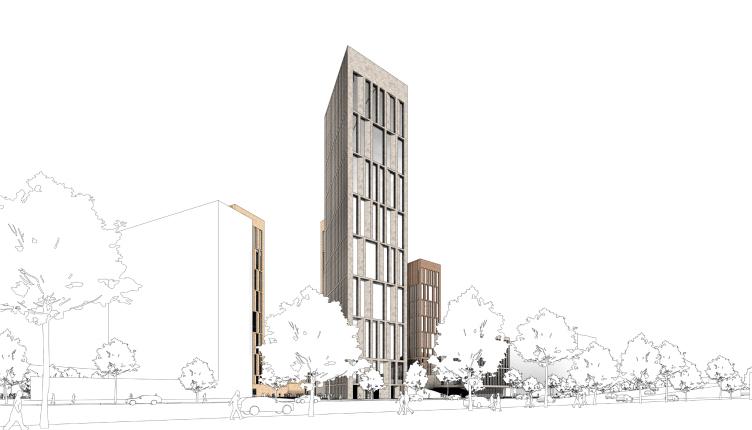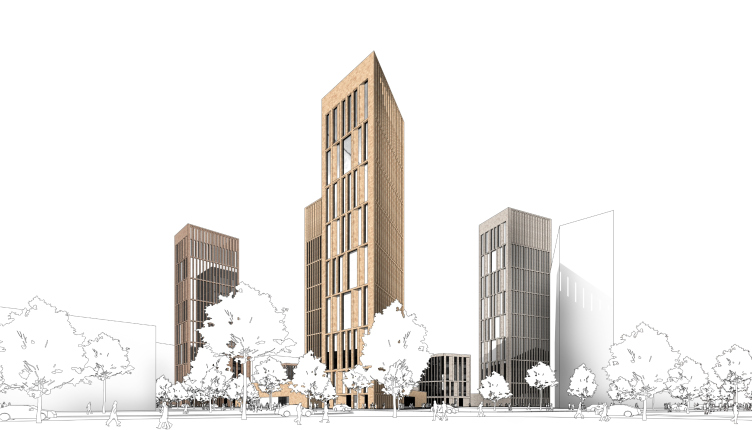The land site, upon which OSA architects have designed a housing complex for the “Brusnika” company, is situated on the axis between the entrance to the “Discovery Arena” and the Volokolamsk highway, from which the new towers will be plainly seen from the cars passing by. Next to it, there is a giant housing complex named “Gorod na Reke Tushino” (“City on the Tushino River”), which occupies nearly half of the peninsula of the former airfield. Compared to “Gorod” and the territory of Vi Holding Development lying behind it, the land site that OSA got to work with is relatively small – about three hectares. However, its location next to one of Moscow’s main highways makes it quite noticeable – making the most of this feature, the architects endowed their complex with an important role of being the propylaea of the new district of the nation’s capital, some volumetric sign that signifies the presence of Tushino in the city fabric.
The housing complex in the Tushino area © OSA architects
The housing complex in the Tushino area © OSA architects
Tushino is an arena for ambitious projects. The red-and-white stadium “Otkritie Arena” for 45 thousand spectators was built to accommodate FIFA-2018, and was acclaimed as one of the best sports facilities 2015. The right to design the concept for the land site of Vi Holding Development was disputed by, among others, Massimiliano Fuksas and Zaha Hadid Architects. The competition was won by Steven Holl Architects and “KAMEN” Architecture Art Group whose buildings look pretty much like parachute hybrids. The houses of “City on the Tushino River” are built upon the projects of SPEECH and TPO “Reserve”.
The OSA architects saw their task “not in trying to continue the string of landmark buildings that create a wow-effect, and not in trying to outshout them, but, rather, in uniting them”. Refraining from repeating any of the surrounding themes, the architects decided to place their bet on more reserved volumes and façades, rather turning their project into a sort of a background for everything that is going on in Tushino in terms architecture. The author of the concept, Vasily Krapivin, says: “We wanted to make sure that our complex is seen from all sides, we wanted it to have plenty of air about it, wanted it to calm and reserved in terms of its building materials”.
The housing complex in the Tushino area © OSA architects
The housing complex in the Tushino area © OSA architects
Apart from the fact that this land site is rather small, it is also pretty complex. In addition to the residential sections, the trapeze outline between the Volokolamsk Highway and two yet-to-be-built drives will also include a hotel and an office center (which are not part of the OSA project). There is also a gas station. Because of the neighbors, the construction blueprint took on an irregular jagged shape. At that time, the client – “Brusnika” developers, with whom OSA already did several projects – gave the architects a free hand setting no budget constraints. Due to the fact that the construction typology was essentially apartments, there weren’t any strict insulation requirements either.
The housing complex in the Tushino area © OSA architects
The site was dissected into a grid of plan modules with a grid space of 8.2 by 8.2 meters. Along the perimeter and through the center run the pedestrian walks that continue the vectors of the pathways from the neighboring areas. This way, the architects got a zone of public spaces, and three construction blueprints. It was decided to put the towers on podiums that contain parking garages inside and shops, offices, and kindergartens on the outside contours, as well as end-to-end lobbies.
The centerpieces of the complex are two towers 32 stories each. The architects arranged them in such a way that even from the remotest vantage points they do not align in a single line, do not start looking like a giant wall, and from all sides look like they are of different height. Along the contours of the podiums, there are extra units from 5 to 12 stories high. This way, the architects were able to achieve a dramatic silhouette, the composition being arranged in such a way that there is plenty of space between the towers. Ultimately, what the architects got was not one but two “scales of construction”: one of the town-planning kind, built on high-rise centerpieces and corresponding to the format of a megalopolis, and the other of a more “human-friendly” kind, closer to the standards of modern urbanists. The yards are placed on top of the podiums and are private and vehicle-free.
The housing complex in the Tushino area. The forming of the public spaces © OSA architects
The housing complex in the Tushino area © OSA architects
The housing complex in the Tushino area © OSA architects
Currently, the project is in the stage of sketchy concept; at this stage, the architects first of all tried to provide rationale for their town planning solutions. The façade design proposed by the architects is rather conditional, although it does support the “noble reserve” theme that was set in the brief – each of the blocks i.e. subjugated to one shade of natural stone: gray, beige and terra-cotta. Currently, the architects speak about the prospects of this complex being actually built with guarded optimism, joking that now the only real project that exists on the land site is the active gas station. But then again, we cannot rule out the possibility that in a while the portfolio of the successful Ekaterinburg-based firm, just as the portfolio of “Brusnika” developers known for the high quality of the volumetric and urban planning solutions, will be enriched by a successfully implemented Moscow project. After all, it’s high time for non-Moscow firms to do some touring.
The housing complex in the Tushino area © OSA architects
The housing complex in the Tushino area © OSA architects
The housing complex in the Tushino area © OSA architects
The housing complex in the Tushino area © OSA architects




